If you're after the lowdown on Pot-Limit Omaha poker, you've landed in the right place. This action-packed poker game is pretty popular among the poker crowd, and the good news is, if you know how to play Texas Hold’Em, you’ll learn how to play Omaha poker in no time. So, here's all you need to know about how to play PLO poker (that stands for Pot-Limit Omaha, by the way) in a flash.
Before we deep dive into Pot-Limit Omaha, though, let's have a brief chat about Omaha Hold’em—or simply Omaha, as it’s commonly referred to by seasoned sharks and newbies alike.
Omaha Poker has three main variants (one of which is the most popular type of Omaha, Pot-Limit—which we'll get to in a sec). You may have seen professional poker players on TV shows like Poker After Dark, playing a strange variant of poker with a fistful of cards—this is Omaha poker. Big players like Patrick Antonius and Viktor “Isildur1” Blom play Pot-Limit Omaha online. Their high-voltage games have resulted in some of the biggest pots in online poker history.
As promised, let’s take a look at Omaha Poker in general before focusing in on its popular variant, Pot-Limit.
OMAHA POKER VARIANTS
Let's explore the Omaha poker rules, before looking specifically at Pot-Limit Omaha.
Blinds: The two players to the left of the Dealer button post the small blind (SB) and big blind (BB). The SB is half the minimum bet, and the BB is equal to the minimum bet.
Dealer Button: The dealer button rotates clockwise, determining the position of play.
Initial Betting: The player to the left of the BB starts the betting round. Players may call, raise, or fold. Each round allows for one bet and up to three raises.
Community Cards:
- Flop: Three community cards are dealt face up after the first betting round.
- Turn: A fourth community card is dealt face up after the second betting round.
River: A fifth community card is dealt face up after the third betting round.
Subsequent Betting Rounds: After each community card is dealt, a betting round occurs. Players can check, bet, call, raise, or fold.
Betting Limits: In No-Limit, there is no limit to what you play; in Fixed-Limit, the amount to be played is fixed, and in Pot-Limit Omaha, bets and raises are capped by the current size of the pot. Betting continues until all active players have called the highest bet or raise.
Showdown: After the final betting round, remaining players reveal their hands. The best five-card hand, using exactly two of their four hole cards and three of the community cards, wins.
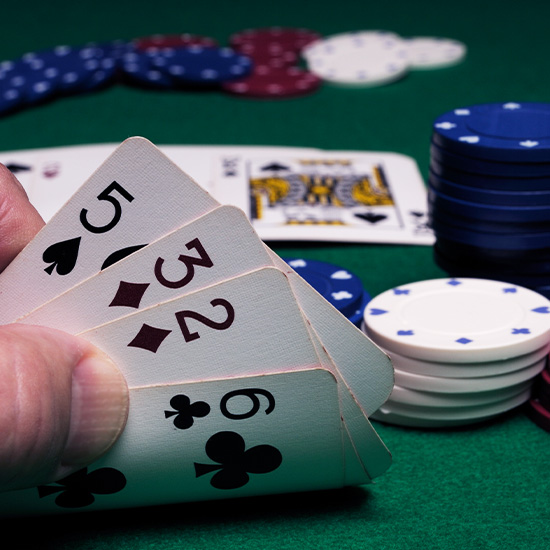
WHAT IS POT-LIMIT OMAHA?
Pot-Limit Omaha is undeniably the most popular form of Omaha poker, played in both tournaments and ring games among top poker pros.
Why is Pot-Limit so popular? Because it’s fast-paced, action-packed, and the rules are very similar to Texas Hold’em. So if you already know how to play Texas Hold'em poker, you should be able to pick up a Pot-Limit Omaha card game in a snap. A much more appealing option so you don’t have to learn a new game from scratch, if you ask us.
In PLO poker, bets and raises are always limited to the size of the pot. While it may seem daunting at first, for most poker players, the jump from playing Texas Hold‘em to Omaha, or indeed Pot-Limit Omaha, is an easy one, and can be picked up in just a few short sessions.
When it comes to high stakes ring games, Pot-Limit Omaha reigns supreme with players like Tom Dwan, Phil Ivey, Barry Greenstein and Joe Hachem, who all favor high-stakes PLO tournaments and Heads Up ring games.
DIFFERENCE BETWEEN POT-LIMIT OMAHA AND TEXAS HOLD'EM
Whilst the basics of Texas Hold'em and Omaha Poker are very similar, Omaha rules are much more complex from a mathematical standpoint, as there are so many more possible card combinations and outcomes to account for.
PLO games tend to be slower than no-limit variants, but they offer more action. The pot-limit betting structure allows players to see the flop, turn, and river more often without being forced out by large bets. Additionally, losses are typically smaller in Pot-Limit Omaha compared to No-Limit Omaha, which appeals to the casual players who make up the majority of the poker community.
Although Omaha Poker has more restrictions on which cards can be used, it also offers more betting options and a larger variety of hand combinations. Texas Hold’em, with its fewer choices, is more straightforward. Despite their similarities, the nuances of each game require different strategies and approaches for success.
While Pot-Limit Omaha is similar to Texas Hold‘em, there are a few key differences:
1. NUMBER OF HOLE CARDS
Texas Hold'em: Each player is dealt two hole cards.
Pot-Limit Omaha (PLO): Each player is dealt four hole cards.
2. HAND FORMATION
Texas Hold'em: Players can use any combination of their two hole cards and the five community cards to make the best five-card hand.
Pot-Limit Omaha (PLO): Players must use exactly two of their four hole cards and three of the five community cards to make their final five-card hand.
3. BETTING STRUCTURE
Texas Hold'em: Typically played as a no-limit game, allowing players to go all-in at any time.
Pot-Limit Omaha (PLO): Played as a pot-limit game, where players can only raise up to the current size of the pot.
4. GAME DYNAMICS
Texas Hold'em: The no-limit format allows for more aggressive play, including the possibility of going all-in.
Pot-Limit Omaha (PLO): The pot-limit structure requires more strategic play and careful management of bets, leading to a more tactical game.
5. TABLE SIZE
Texas Hold'em: Typically played with 2-10 players at a table.
Pot-Limit Omaha (PLO): Can also accommodate 2-10 players, with 6-max being common when playing online social poker.
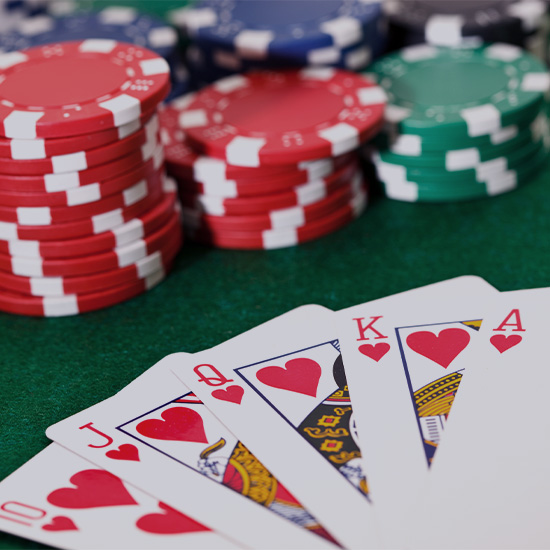
OMAHA POKER HAND RANKINGS: PROBABILITY
In Omaha Poker, players receive four hole cards instead of two as seen in Texas Hold'em, so the chance of making high-ranked hands is increased. While in Texas Hold’em a two pair or lower hand might win, in Omaha such hands usually don't make it past the first round and rarely win at showdown.
For example, in Hold’em, pocket aces have about an 82% chance of beating pocket kings. In Omaha, however, pocket aces with two other cards have just under a 60% chance against kings with two other cards.
Hand selection is crucial in Omaha, especially in Pot-Limit Omaha (PLO), where more players often reach the showdown. Pairs are common in most poker games, but they are less valuable in Pot-Limit Omaha as the game progresses.
POT-LIMIT OMAHA POKER HANDS
When you’re learning to play PLO, knowing how to choose between good and bad starting hands is crucial. Good hands typically consist of connected cards, pairs, and suited combinations, as they offer high potential. A successful Omaha strategy involves understanding the potential of the starting hand and considering its strength and position, and adapting to community cards, while being mindful of potential high hands.
While good and bad starting hands differ between PLO and Texas Hold’em, the hand rankings in both variants remain the same.
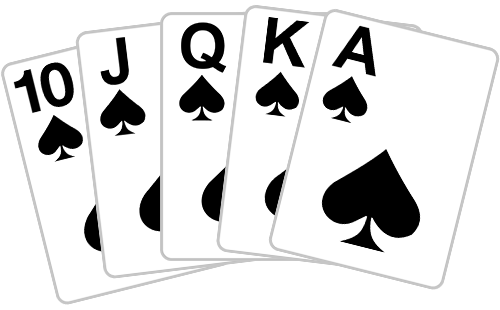
Royal Flush
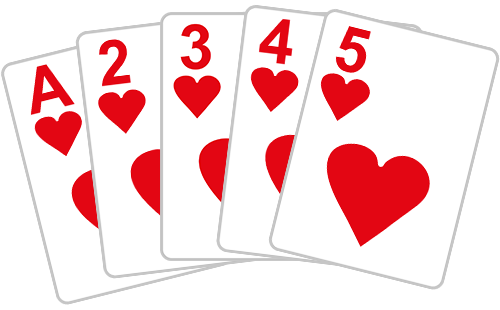
Straight Flush
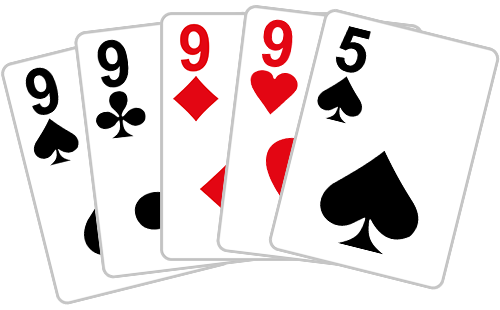
Four of a Kind
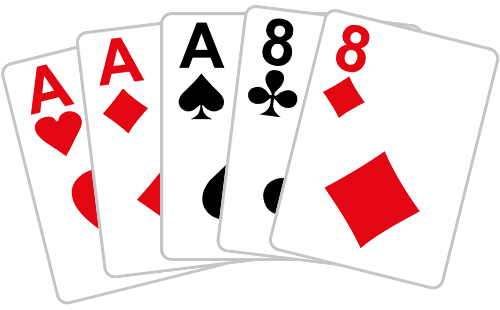
Full House
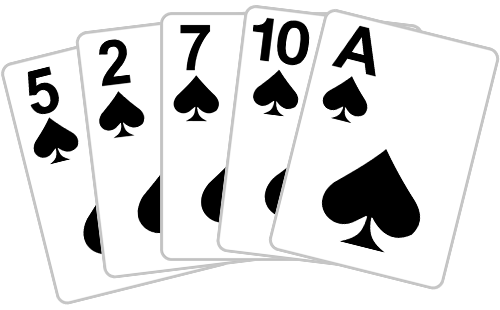
Flush
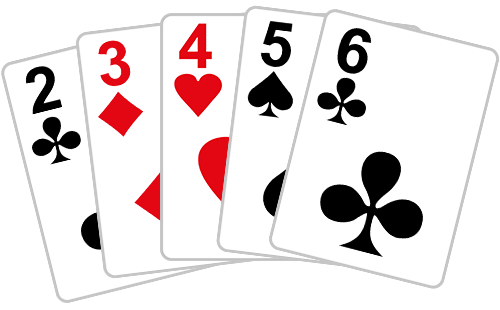
Straight
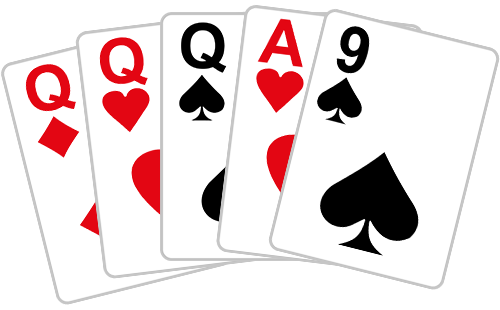
Three of a Kind

Two Pair

One Pair
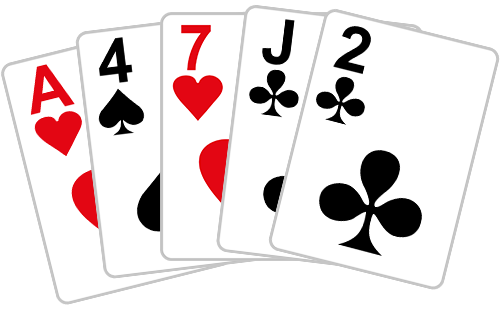
High Card
| Hand | Odds | Description |
| Royal Flush |
1 in 10,870 | The absolute holy grail and nuts in poker - a straight flush includes Ace, King, Queen, Jack, and Ten all in the same suit. The chances of getting a Royal Flush in PLO? A mere 0.000092%. |
| Straight Flush |
1 in 1,260 | Five consecutive cards of the same suit. |
| Four of a Kind |
1 in 208 | Four cards of the same rank. |
| Full House |
1 in 16 | Three of a kind, as well as two cards of a different rank making two pair. Also known as a “boat”. FYI: You will always need a pair on the board to make a full house! |
| Flush |
1 in 15 | Any five cards of the same suit. |
| Straight |
1 in 9 | Five cards in numerical order but different suits. If it’s an Ace-high straight, this is what’s known as a “Broadway”. |
| Three of a Kind |
1 in 11 | Three cards, same rank - aka “trips” |
| Two Pair |
1 in 3 | Two cards, same rank. Another two cards, another rank. Plus one card of any rank - the kicker. |
| One Pair |
1 in 4 | Two cards. Same rank. Simple. |
| High Card |
1 in 34 | Just play the highest card in your hand if you’ve got nothin else. |
Check out our poker hand rankings page for a super detailed breakdown!

BEST (AND WORST) STARTING HANDS IN POT-LIMIT OMAHA POKER
BEST STARTING HAND
The best starting hand in PLO is a double-suited AAKK (e.g., A♠ A♦ K♠ K♦). This hand is incredibly strong because it offers top pair (Aces), the potential for a broadway straight, and two flush draws. Other powerful starting hands include combinations like double-suited AKQJ, which provide strong connectivity and multiple ways to build winning hands.
.jpg?h=600&iar=0&w=1200)
WORST STARTING HAND
And the worst starting hand? That would be having four of a kind (particularly 2222)—because unfortunately this means that you can never improve beyond a pair.
Why? Well, remember when we said players must use exactly two of their four hole cards and three of the five community cards to make their final five-card hand? If you have four of a kind in your hand, you have to discard two of them, leaving you no chance of improving to trips or better using the community cards. This is why Omaha poker is considered a game of outs.
As for four Aces? While it sounds impressive, it faces the same problem—you're still limited to using only two Aces, so quads are off the table. Instead, you'd just be left with a fairly weak and unplayable hand in most situations.
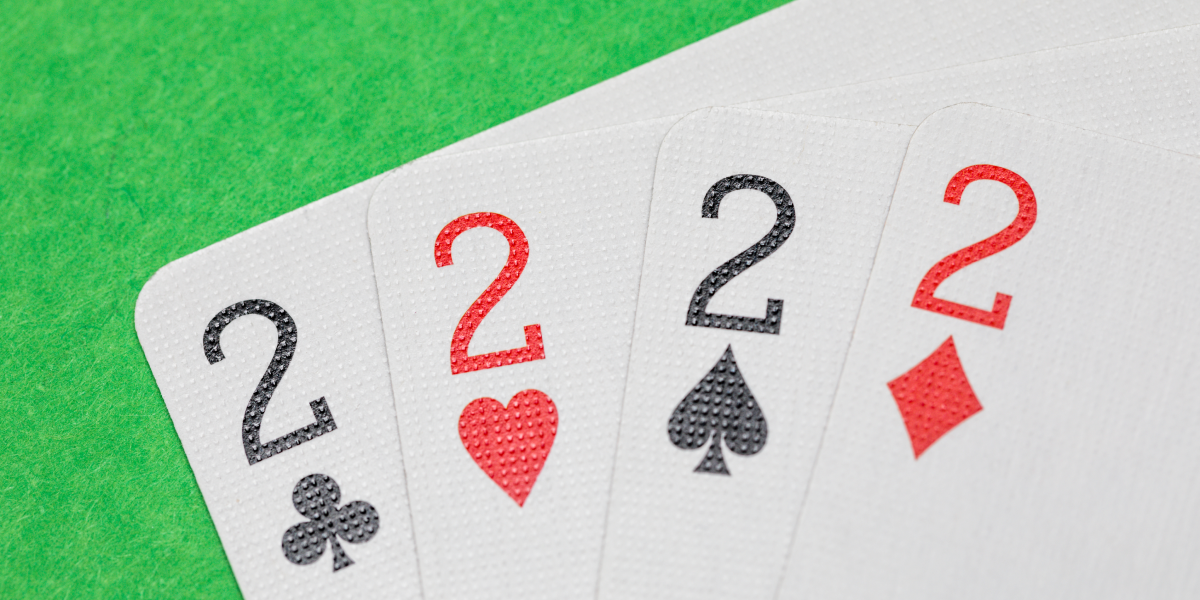
POT-LIMIT OMAHA: POKER STRATEGIES FOR PLO
One of the first things new players will notice about playing Pot-Limit Omaha is that a top pair just ain't gonna cut it.
And, since players can only bet or raise the size of the pot, pre-flop, all-ins are less frequent. Think of PLO poker as a ‘drawing game’—it’s more likely that there will be straights, flushes, and full houses by the river. Due to this increased likelihood of trips, straights, flushes and full houses, you really want to be holding the nuts in Omaha. Since Omaha is a game of outs, players tend to see more flops as they are trying to draw to get a better hand. The good news is that more players seeing flops means more chips in the pot overall.
As with Texas Hold‘em, to win at Pot-Limit Omaha, you still need to know when to play a hand, when to bet, when to bluff, and when to fold. Also, position is still important. You’ll still want to play the position like you would in a regular game of poker. If the players before you are behaving passively, try a little aggression, especially if you’re in a late position (on the cut-off or the button) – make a bet to see if you can steal the pot, or at least get some people out of the hand.
As with any poker variant, there’s no one perfect strategy for Pot-Limit Omaha, but here are a few tips to help you gain an edge when you begin playing PLO:
Evaluate your starting hands: Pocket Aces aren’t the nuts in Omaha—while this hand is still worth playing, don’t rely on a top pair to take down the pot, especially in a hand with multi-way action. Your pocket Aces are definitely more likely to get busted post-flop!
Be patient with the hands you choose to play: As with Texas Hold‘em, don’t just play any hand. Remember—tight is right!
Know when to play, bet, bluff and fold: There tends to be less bluffing in Omaha, so you really want to be holding the nuts at showdown.
- Draw chips out of your opponents: If you have made a very strong hand, and especially if you are holding the nuts, you want to draw as many chips out of your opponents as possible. Instead of telegraphing the strength of your hand with big bets, try to draw more value out of your hand by just calling—let your opponents pay you off!
POT-LIMIT OMAHA: POKER STRATEGIES FOR PLO
It’s important to be aware of bet sizing when learning how to play Pot-Limit Omaha, as it's a crucial aspect of the game.
If you’re playing Pot-Limit Omaha online, it’s easier to keep track of the pot size as it’s displayed on the board. Also, you can simply click the “pot” button which makes betting the maximum easier. If you’re in a live game of PLO poker, you can say “pot” before betting, and the dealer will help you work out the amount that is in the pot.
Considering the majority of hands are won with flushes and straights, it’s harder to get opponents to fold by simply betting on the flop. Most players will still be drawing to a better hand on the flop and are therefore more likely to call or even raise with a draw. This is a solid strategy, and one which you might consider employing.
Remember: just because you can bet the pot, doesn’t mean you always should!
GLOSSARY OF OMAHA POKER TERMS
Since Pot-Limit Omaha rules are the same as Texas Hold‘em poker when it comes to blinds and order of play, the terms used are the same, and should be familiar to you Texas Hold‘em players. For new players though, these terms may be a bit confusing.
Luckily for you, we've put together a glossary of the most common poker terms:
SB
Small Blind. The Small Blind is paid by the player in the position to the immediate left of the dealer button. The small blind is equal to half the minimum bet.
BB
Big Blind. The Big Blind is paid by the player in the position two places to the left of the dealer button. The big blind is equal to the minimum bet.
Ante
The ante is a stake put up by players in poker before the cards are dealt. Both blinds and antes are forced bets, but all players must put antes in the pot before cards are dealt. The ante is there to give players an incentive to play, as well as to help build the pot.
Straddle
A straddle is a voluntary bet made by a player after the blinds have been posted, but before the cards are dealt. The only player with the option to straddle is the player who would be first to act, i.e. the player to the immediate left of the big blind. The best way to think of it is an optional ‘third blind’.
Under The Gun (UTG)
The player to the immediate left of the big blind, who is first to act after the blinds have been posted.
Cut-off
The player in the position to the immediate right of the button. Button: The player sitting in the position on the Dealer button. This is the last player to act before the small and big blind players.
Street/s
A very confusing term for new players. The term “street” is used to describe which part of the hand the game has progressed to. The best way to understand it is that the number of cards you have been dealt equates to the street that you are on – i.e. three cards = the flop, and both the flop and the subsequent betting round is known as “third street”. It can be confusing as there is no first or second street!
Fourth street is the dealing of both the turn card and the betting round that follows. It represents the third round of betting. It is called the fourth street as it is the fourth community card to be dealt. Fifth street is both the dealing of the river card and the betting round that follows. As with fourth street, fifth street is so-called as it is the fifth community card to be dealt.
Gutshot Draw
When you have draw to straight that requires an inside card, e.g. holding 45 as your hole cards on a 668 flop – requiring a 7 on either the turn or river to make the straight.
Open-Ended Draw
When you have four consecutive cards, and only require two different value cards to make a straight – e.g. hole cards 45, with a 369 flop – you need either a 2 or a 7 to be dealt on the turn or river to make the straight.
Backdoor Flush Draw
When you have three cards of the same suit on the flop (using both hole cards and community cards), but need both the turn and river cards to make a flush.
Runner Runner
This term is used to describe a hand which was made only by catching the necessary cards on both the turn and the river.
FREQUENTLY ASKED QUESTIONS ABOUT POT-LIMIT OMAHA POKER
What are the basic rules of Pot-Limit Omaha?
In Pot-Limit Omaha, each player is dealt four private cards (known as hole cards) and must use exactly two of them in combination with three of the five community cards to make the best five-card hand. Unlike Texas Hold'em, where players can use any combination of hole and community cards, PLO requires using exactly two hole cards and three community cards. The game follows the pot-limit betting structure, where the maximum bet is the current size of the pot.
How does betting work in Pot-Limit Omaha?
In Pot-Limit Omaha, the maximum bet you can make is determined by the size of the pot at the start of your betting round. This betting structure can lead to larger pots and more strategic play.
What is the best strategy for Pot-Limit Omaha?
Pot-Limit Omaha strategy involves focusing on strong starting hands and understanding the potential for big draws. Because you have four hole cards, the likelihood of making strong hands or drawing to them is higher than in Texas Hold'em. Prioritize starting hands that can make the nuts (the best possible hand) or have the potential for multiple draws. Also, be cautious with your bets and raises, considering the pot size and your opponents’ potential hands.
How is Pot-Limit Omaha different from Texas Hold'em?
The primary difference is in the number of hole cards each player receives—four in PLO versus two in Texas Hold'em. In addition, PLO requires players to use exactly two hole cards and three community cards to make a hand, whereas in Hold'em, players can use any combination of hole and community cards. This makes hand combinations and drawing potential more complex in PLO. The betting structure in PLO is pot-limit, which can lead to larger bets and pots compared to the no-limit structure of Hold'em.
What are some common mistakes to avoid in Pot-Limit Omaha?
Common mistakes in Pot-Limit Omaha include playing too many hands, overvaluing hands, and mismanaging pot control. Because PLO deals four hole cards, players often get involved in more hands than they should. Avoid getting too attached to hands that are strong in other games but not in PLO. Also, be mindful of the pot size and avoid making overly large bets that can deplete your stack quickly. Proper hand selection and disciplined play are crucial for success in PLO.
MORE MUST-READ POKER GUIDES

HOW TO PLAY TEXAS HOLDEM

HOW TO PLAY OMAHA HIGH/LOW

HOW TO PLAY BOUNTY HUNTERS

HOW TO PLAY CRAZY PINEAPPLE POKER